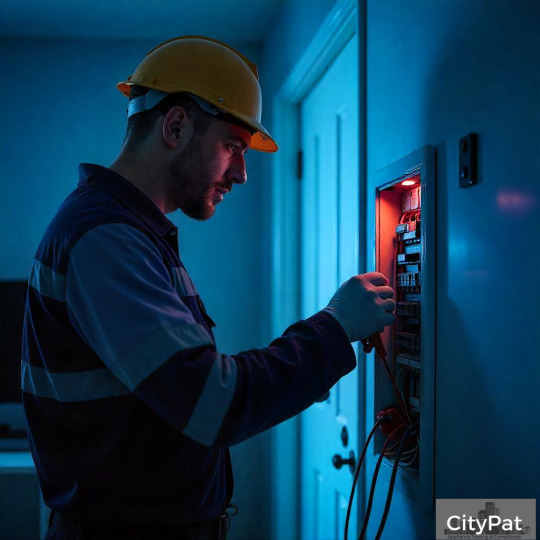#HomeSafetyCheck
Explore tagged Tumblr posts
Text
EICR Test Procedure Explained: A Complete Guide for Property Owners in the UK
When it comes to electrical safety in homes and businesses, the Electrical Installation Condition Report (EICR) plays a crucial role. Whether you're a landlord, a homeowner, or a business owner, understanding the EICR test procedure is essential to remain compliant with UK regulations and to ensure the safety of your property’s electrical systems.

In this comprehensive guide, we break down the EICR test procedure step-by-step, explain its significance, and outline what you can expect during an inspection.
What is an EICR?
An Electrical Installation Condition Report (EICR) is a formal document produced following an assessment of the electrical systems within a property. This inspection is carried out by a qualified electrician or an approved contractor to determine whether the electrical installations are safe, properly maintained, and compliant with current standards.
Why is an EICR Important?
Legal Requirement for Landlords As of July 1, 2020, it’s a legal requirement in England for landlords to have their rental properties inspected every five years or at the beginning of a new tenancy. Failing to comply can lead to heavy penalties.
Prevention of Electrical Hazards Regular EICR tests help detect faults that could lead to electric shocks, fires, or other dangerous situations.
Insurance Compliance Some insurance providers require an up-to-date EICR as a condition of coverage, especially for commercial properties.
Peace of Mind Whether it's your home or business, an EICR gives you confidence in the safety and reliability of your electrical systems.
EICR Test Procedure: Step-by-Step
Here’s a clear breakdown of the EICR test procedure carried out by certified electricians:
1. Initial Visual Inspection
The process begins with a thorough visual inspection of the electrical installations, including:
Consumer units (fuse boxes)
Sockets and switches
Wiring condition
Evidence of overheating or damage
Signs of previous DIY electrical work
This helps the electrician identify any obvious issues before moving on to more technical testing.
2. Dead Testing
The next stage involves "dead testing" – tests carried out when the electrical system is turned off. These include:
Continuity Testing: Ensures all conductors are properly connected and intact.
Insulation Resistance Testing: Verifies that the insulation around the cables is intact and prevents current from leaking.
Polarity Check: Confirms that wires are connected to the correct terminals.
These tests help determine the integrity and safety of the fixed wiring without any electrical flow.
3. Live Testing
Once dead tests are complete, live testing is conducted. These tests are done with the power on, under controlled conditions:
Earth Fault Loop Impedance Test: Measures how quickly the system disconnects in the event of a fault.
RCD Testing (Residual Current Devices): Ensures that RCDs operate within required disconnection times, which is crucial in preventing electric shocks.
Live tests must only be performed by qualified and experienced professionals due to the risks involved.
4. Functional Testing
The electrician will then check the operation of various components to make sure everything functions as intended:
Lights
Switches
Socket outlets
Smoke detectors (if integrated with the electrical system)
Any anomalies will be noted and addressed in the final report.
5. Documentation and Report
After the inspection, the electrician will compile all findings into an EICR document. The report categorises issues as follows:
C1 (Danger Present) – Immediate action required.
C2 (Potentially Dangerous) – Urgent remedial work required.
C3 (Improvement Recommended) – Not dangerous but could enhance safety.
FI (Further Investigation Required) – Unclear issue, further testing needed.
If C1 or C2 issues are found, the property fails the test, and remedial work is required to pass.
What Happens If You Fail an EICR Test?
If your property fails the EICR test, you’ll need to carry out the necessary remedial work as soon as possible. Once completed, a satisfactory certificate or a follow-up report will be issued to confirm that the electrical system meets safety standards.
For landlords, this is a legal requirement, and failure to act promptly can result in fines of up to £30,000.
How Often Should You Get an EICR?
The recommended frequency of an EICR test depends on the type of property:
Rental Properties: Every 5 years or with each new tenancy
Owner-Occupied Homes: Every 10 years
Commercial Premises: Every 5 years
Industrial Sites: Every 3 years
Public Buildings (e.g. schools): Every 5 years or as specified
How to Prepare for an EICR Inspection
Before the inspection, make sure:
Access is available to all areas (especially fuse boxes and sockets)
Devices and appliances are unplugged if requested
Pets or occupants are safely out of the way
Hiring a reputable company like City PAT UK ensures a professional, certified approach with minimal disruption.
Why Choose City PAT UK for EICR Testing?
At City PAT UK, we specialise in electrical testing and certification services for homes, landlords, and businesses. Our qualified electricians follow the latest safety guidelines and use advanced testing equipment to deliver thorough and reliable EICRs.
We offer:
Affordable pricing
Prompt appointment scheduling
Detailed reports
Remedial services if needed
Final Thoughts
Understanding the EICR test procedure is vital for anyone responsible for a property. It not only ensures safety and legal compliance but also protects you from costly repairs or potential accidents.
If you're due for an inspection or unsure about the state of your electrical systems, don’t wait—schedule your EICR test with City PAT UK today.
Call us : 01423 534 666 Email : [email protected] Website : https://citypat.co.uk/
0 notes